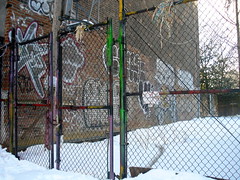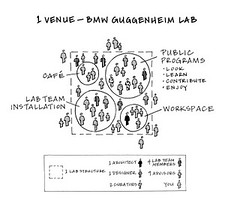 Crystal BellAfter years of complaining about the rat problem in this vacant lot on East First Street, residents will welcome the BMW Guggenheim Lab to the site this summer.
Crystal BellAfter years of complaining about the rat problem in this vacant lot on East First Street, residents will welcome the BMW Guggenheim Lab to the site this summer. For Ann Shostrom, a local artist and resident of 35 East First Street, the constant screams and shrieks outside her window have become a nightly lullaby. No, her block isn’t particularly violent or dangerous, but it does have a huge problem, or more like thousands of little, scampering ones.
The residents on the block all seem to agree that the rat infestation on First Street between First and Second Avenues is the worst they have ever seen. And chances are if you’ve walked past the vacant lot located on 33 East First Street, then you probably feel the same way.
“I’m so acquainted with the rats now that I’m not afraid of them anymore,” said John Bowman, a professor at Pennsylvania State University and Ms. Shostrom’s husband. “We start to recognize some of them. There’s a big guy I call Bruno. But there are just so many of them. Kids on the block have had a rat safari. It’s dangerous.”
So Ms. Shostrom and her husband decided to take action and in 2008, created First Street Green, a grassroots organization dedicated to cleaning up the lot and turning into a community sculpture park. They raised funds through summer bake sales, art shows and benefits, but progress was slow. But their project received an unexpected boost last year, when the Solomon R. Guggenheim Museum, decided that the block’s eyesore was the perfect place for their 5,000-square-foot traveling urban lab.
“They have money, and we need something done about the site,” said Ms. Shostrom. “With this economy, the city doesn’t have the money and the Parks Department certainly doesn’t have the money, so this was just perfect for the community.”
The BMW Guggenheim Lab, which is being funded in part by the automobile company, is a movable structure that plans to bring together international scholars, scientists, artists and community members to share ideas and try to come up with practical solutions to major issues affecting urban life. It will be open to the community from early August to mid-October 2011, before moving on to cities in Europe and Asia.
The idea for the lab came from Maria Nicanor and David van der Leer, curators for the Guggenheim, who envisioned a space for community members to think about the future. For Ms. Nicanor, New York City seemed like an obvious place to begin the project but finding a location wasn’t easy.
“David and I got on our bikes, and the first area we went to was the East Village,” said Ms. Nicanor. “We literally biked every single street, up and down, looking for places we liked, and then we identified this area on First Street. It’s right on the border of the East Village and the Lower East Side and close to Chinatown. It’s such a diverse spot.”
In addition to hosting free public events and educational programs, the lab will also have an outdoor café, selling drinks from local coffee vendors. Profits from the café will go to the vendors themselves, which Guggenheim officials said was meant to be a way to contribute to the community they will be visiting.
But perhaps the museum’s greatest gift to the East Village will be the permanent renovation of the rat-ridden lot.
“We know the area has a rat problem, so once we move out of the space, we’re going to be leaving a permanent masonry pavement behind,” Ms. Nicanor said. “The whole area will be replanted and will be left in much better shape than it is now.”
And for the tenants of 35 East First Street, that is of no small consequence.
“We don’t hate the rats or wish them to perish,” said Mr. Bowman. “We just would like them to relocate. Even a few of them can stick around, because what would the East Village be without a few rats?”
Join the conversation: What do you think of the Guggenheim’s urban lab idea? Share your thoughts in the comments section below.




